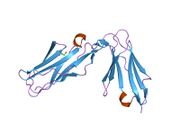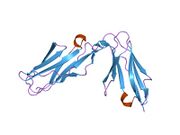Biology:NCR1
From HandWiki
Short description: Mammalian protein found in Homo sapiens
 Generic protein structure example |
Natural cytotoxicity triggering receptor 1 is a protein that in humans is encoded by the NCR1 gene.[1][2] NCR1 has also been designated as CD335 (cluster of differentiation, NKP46, NKp46, NK-p46, and LY94.[3]
References
- ↑ "Molecular cloning of NKp46: a novel member of the immunoglobulin superfamily involved in triggering of natural cytotoxicity". J Exp Med 188 (5): 953–60. Sep 1998. doi:10.1084/jem.188.5.953. PMID 9730896.
- ↑ "Entrez Gene: NCR1 natural cytotoxicity triggering receptor 1". https://www.ncbi.nlm.nih.gov/sites/entrez?Db=gene&Cmd=ShowDetailView&TermToSearch=9437.
- ↑ "NCR1 natural cytotoxicity triggering receptor 1 [Homo sapiens (human)] - Gene - NCBI". https://www.ncbi.nlm.nih.gov/gene/9437.
Further reading
- Biassoni R; Cantoni C; Marras D et al. (2004). "Human natural killer cell receptors: insights into their molecular function and structure". J. Cell. Mol. Med. 7 (4): 376–87. doi:10.1111/j.1582-4934.2003.tb00240.x. PMID 14754506.
- Sivori S; Vitale M; Morelli L et al. (1997). "p46, a Novel Natural Killer Cell–specific Surface Molecule That Mediates Cell Activation". J. Exp. Med. 186 (7): 1129–36. doi:10.1084/jem.186.7.1129. PMID 9314561.
- Vitale M; Bottino C; Sivori S et al. (1998). "NKp44, a Novel Triggering Surface Molecule Specifically Expressed by Activated Natural Killer Cells, Is Involved in Non–Major Histocompatibility Complex–restricted Tumor Cell Lysis". J. Exp. Med. 187 (12): 2065–72. doi:10.1084/jem.187.12.2065. PMID 9625766.
- Cantoni C; Bottino C; Vitale M et al. (1999). "NKp44, A Triggering Receptor Involved in Tumor Cell Lysis by Activated Human Natural Killer Cells, Is a Novel Member of the Immunoglobulin Superfamily". J. Exp. Med. 189 (5): 787–96. doi:10.1084/jem.189.5.787. PMID 10049942.
- Vankayalapati R; Wizel B; Weis SE et al. (2002). "The NKp46 receptor contributes to NK cell lysis of mononuclear phagocytes infected with an intracellular bacterium". J. Immunol. 168 (7): 3451–7. doi:10.4049/jimmunol.168.7.3451. PMID 11907104.
- Strausberg RL; Feingold EA; Grouse LH et al. (2003). "Generation and initial analysis of more than 15,000 full-length human and mouse cDNA sequences". Proc. Natl. Acad. Sci. U.S.A. 99 (26): 16899–903. doi:10.1073/pnas.242603899. PMID 12477932. Bibcode: 2002PNAS...9916899M.
- Augugliaro R; Parolini S; Castriconi R et al. (2003). "Selective cross-talk among natural cytotoxicity receptors in human natural killer cells". Eur. J. Immunol. 33 (5): 1235–41. doi:10.1002/eji.200323896. PMID 12731048.
- Ponassi M; Cantoni C; Biassoni R et al. (2003). "Structure of the human NK cell triggering receptor NKp46 ectodomain". Biochem. Biophys. Res. Commun. 309 (2): 317–23. doi:10.1016/j.bbrc.2003.08.007. PMID 12951052.
- "Crystal structure of the human natural killer (NK) cell activating receptor NKp46 reveals structural relationship to other leukocyte receptor complex immunoreceptors". J. Biol. Chem. 278 (46): 46081–6. 2003. doi:10.1074/jbc.M308491200. PMID 12960161.
- Arnon TI; Achdout H; Lieberman N et al. (2004). "The mechanisms controlling the recognition of tumor- and virus-infected cells by NKp46". Blood 103 (2): 664–72. doi:10.1182/blood-2003-05-1716. PMID 14504081.
- Marcenaro E; Augugliaro R; Falco M et al. (2004). "CD59 is physically and functionally associated with natural cytotoxicity receptors and activates human NK cell-mediated cytotoxicity". Eur. J. Immunol. 33 (12): 3367–76. doi:10.1002/eji.200324425. PMID 14635045.
- Carbone E; Neri P; Mesuraca M et al. (2005). "HLA class I, NKG2D, and natural cytotoxicity receptors regulate multiple myeloma cell recognition by natural killer cells". Blood 105 (1): 251–8. doi:10.1182/blood-2004-04-1422. PMID 15328155.
- Gerhard DS; Wagner L; Feingold EA et al. (2004). "The Status, Quality, and Expansion of the NIH Full-Length cDNA Project: The Mammalian Gene Collection (MGC)". Genome Res. 14 (10B): 2121–7. doi:10.1101/gr.2596504. PMID 15489334.
- "Effects of prolactin and cortisol on natural killer (NK) cell surface expression and function of human natural cytotoxicity receptors (NKp46, NKp44 and NKp30)". Clin. Exp. Immunol. 139 (2): 287–96. 2005. doi:10.1111/j.1365-2249.2004.02686.x. PMID 15654827.
- Nowbakht P; Ionescu MC; Rohner A et al. (2005). "Ligands for natural killer cell-activating receptors are expressed upon the maturation of normal myelomonocytic cells but at low levels in acute myeloid leukemias". Blood 105 (9): 3615–22. doi:10.1182/blood-2004-07-2585. PMID 15657183.
- Poggi A; Massaro AM; Negrini S et al. (2005). "Tumor-induced apoptosis of human IL-2-activated NK cells: role of natural cytotoxicity receptors". J. Immunol. 174 (5): 2653–60. doi:10.4049/jimmunol.174.5.2653. PMID 15728472.
- Zilka A; Landau G; Hershkovitz O et al. (2006). "Characterization of the heparin/heparan sulfate binding site of the natural cytotoxicity receptor NKp46". Biochemistry 44 (44): 14477–85. doi:10.1021/bi051241s. PMID 16262248.
- Hermann E; Alonso-Vega C; Berthe A et al. (2006). "Human congenital infection with Trypanosoma cruzi induces phenotypic and functional modifications of cord blood NK cells". Pediatr. Res. 60 (1): 38–43. doi:10.1203/01.pdr.0000220335.05588.ea. PMID 16690951.
External links
- NCR1+protein,+human at the US National Library of Medicine Medical Subject Headings (MeSH)
- Overview of all the structural information available in the PDB for UniProt: O76036 (Natural cytotoxicity triggering receptor 1) at the PDBe-KB.
 |



